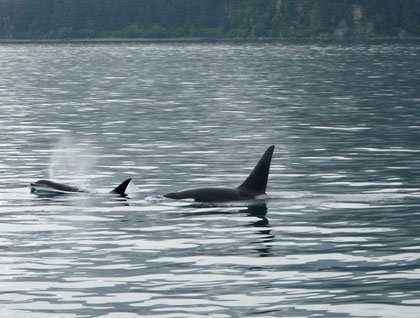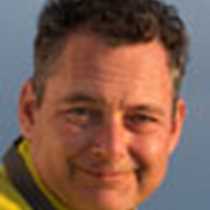If you can imagine a day in which we did pretty much everything, you are thinking of our day in Southeast Alaska. After leaving Lake Eva and poking into Sitkoh Bay, last night we headed north through Chatham Strait, then turned into Icy Strait in the early morning hours. As we have seen, Southeast Alaska is characterized by enormous tidal variations. All of that water must enter the inland waters on a rising tide, and flow out again on a falling tide, through Icy Strait, north of Chichagof Island, or around the southern end of Baranof Island. Twice each day, the water comes in, the water flows out. Incoming tides bring nutrients from the adjacent Pacific Ocean, and the fish that come to spawn in the rivers, streams, and lakes of the land. Consequently, Icy Strait is rich in productivity and in food for oceanic wildlife.
By ones and twos, we gathered on the foredeck of National Geographic Sea Bird in the early morning mist, steaming mugs of coffee in hand. In the distance we could see the tall spouts of humpback whales against the dark forest of Chichagof Island, but before we could reach them for closer observation we spotted the small, puffy blows and pointed dorsal fins of…killer whales. Would the larger whales flee in panic at the presence of these marine predators? Well, no, because these turned out to be the fish-eating morph of Pacific Northwest killer whales, the form that we call "residents." The fish-eating and mammal-eating forms of the killer whale differ in both behavior and morphology, and they do not interbreed. They are, in fact, distinct species.
These whales gave us wonderful views, the mature males with tall, erect dorsal fins, females and immature males with smaller dorsal fins that arc backward. Two whales approached the ship and passed beneath us and out the other side, to a cacophony of camera clicks. And all of this before breakfast!
Morning activities offered an opportunity to kayak around Shaw Island, in Idaho Inlet, and/or to walk through the forest at Fox Creek. There we saw a perennial bear trail made over who-know-how-many decades of use, each bear placing its feet in exactly same depressions in the mossy ground. By this means, and by scratching as high up trees as they can reach, coastal brown bears advertise their presence, their size, and, by pheromones left in the depressions, their reproductive status to others of their kind.
A short drive took us to the Inian Islands and we boarded our expedition landing craft for a tour around the islands. On rocks adjacent to the tidal flow, and in the roiling water itself, we found large numbers of Steller's sea lions feasting on fish brought by the incoming tide. Before they are large enough to compete for space on a breeding colony, there is little for a young sea lion to do but eat and grow larger, and they hang out together at communal "haul-outs" such as this. Among the young males were some immense, older males. These have probably taken their turn at the breeding colony until they were defeated in the competition with other males.
Each time a fish was taken the sea lion rose to the surface with its prey grasped in its sharp teeth, and tossed its head violently to break the fish into pieces of a size to be swallowed. This attracted the gulls that accompanied this feeding frenzy to squabble for their share. Even majestic bald eagles were attracted to the fray, all feasting on the rich marine productivity.
Did I remember to mention the breaching humpback whale?









